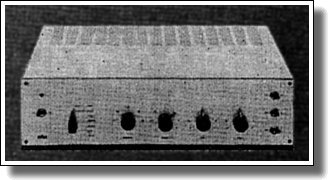Potential Improovements
After my opinion the people at BRAUN designed the final amplifier stage a tad too optimistical and cost-efficient back then. The negative bias voltage is derived from the final stage heater voltage with the BYY35 diode (GL4), filtered by a 4µF (C11) and reads -49V. This raw voltage is fed via a current-limiter 10K (R6) and a 20K trimmer (R7) for adjustment. This voltage is again filtered by a 4µF capacitor (C10) and then fed to both final amplifiers.
There the raw bias voltage is fed into the symmetry stage after the phase splitter and the controls R316 / R416 (20K each) are used to tune the balancing between the two tubes per channel.
Theoretically no problem - given both output transformers are absolutely identical and have identical Raa, so that the quieceance current across the tubes is also identical. The design does not take in account that transformers may differ. Here it is possible to symmetrize each channel - but it does not allow to tune out the differences between channels.
Maybe I am too picky here and maybe no one really cares and / or wants to keep the original condition under any circumstance. Well - then forget about it.
But for the sake of performance it would be much better to build two separate circuits for the pre-bias. Means: 2 diodes, 2 filter caps, 2 current-limiting resistors, 2 trimmers and 2 more filtering caps.
The BYY35 is a 500 Volt / 0.6 Amps Si-Diode. A 1N4007 should do the trick as well. You need to pick a 22 K resistor for the current-limiting R6 and a 22K trimmer. The caps need to be 4.7µF / 63V at least.
Now for the settings .... but there are none given and I don't have the entire service manual or the maintenance advisory. Just the service plans. So there's a lot guesswork in here and I am probably scating on thin ice with my calculations.
Correct me if I am totally wrong, Okay ? Fine.
Here's my best guess.
Warning ! Below that line everything in this chapter is purely speculative !
The technically similar CSV13 is biased to 18 - 24 mA anode current ... with an indentically poor bias circuitry common for both channels. The tube cathodes are also directly tied to GND and we simply assume that there is a relation between the current flow with no signal and full power. The CSV13 puts out 12 Watt sine per channel. According to the schematic the voltage drop across the output transformer in idle is (320 V - 315 V) = 5 V. I think 18 mA idle current is preferred, so that would equal 5 V / 0.018 Ohms = 280 R DC-resistance for that transformer. For 12 W output power and 315 V on the tube you need 12 Watt / 315 V = 70 mA total current = 35 mA per side. The idle current then equals about 50 % of the full power current.
Given that "design rule" also applies to the CSV60 and the PL500's you could do the following calculation: 30 Watts output power and 345 V across each tube result in 30 W / 345 V = 87 mA "audio current" = 43 mA per side. If the idle current is also 50% of that, the tubes should be adjusted to 21.5 mA.
If that is correct, let's assume the supply voltage is 350 V - achieved by (almost) doubling the 180 V from the transformer. 350 V - 345 V across the tubes = 5 V drop across the output transformer. Given 21.5 mA is near the correct current the transformer should have 5 V / 21.5 mA = 233 Ohms DC resistance. And that is easy to test with unplugged amplifier and a multimeter between anode cap and the "Plus" pin of C6 / C4 / cathode of diode GL1.
Now for the adjustments.
Easiest to adjust is the tube-to-tube balance. Just tie a multimeter to the anode caps of each tube pair in a channel. Wait until the amplifier has warmed up for at least 15 minutes. Then turn R316 (or R416 on the other channel) until the meter reads "0.0 VDC". Repeat that step on the other amplifier. Voilá: balanced.
Then remove the multimeter and tie it to GND and one anode cap. Turn the pre-bias voltage trimmer until the meter reads "345 VDC". If you had separated the pre-bias you need to repeat that step on the other channel.
Test the voltages on the other tubes or the balance again on both pairs and you are through.
Repeat the steps if required until you have both, proper balance and proper voltage.
Then - for curiosity - turn the amp off and install a multimeter in current probing between output transformer and one anode cap. To which current does it stabilize after -say- five minutes ? 21.5 mA ?
It would surely be better to have a good-running CSV60 at hand and test out the currents and voltages before - and check out the R and Z of the output transformer. I had never been too good in mathematics.
Too wildly guessed ? Let me know.
Some words on line voltages
When this unit was designed in the early 1960's german line voltage was 220 VAC. In the mid-90s the european power network was "harmonized" and the common average supply voltage was lifted to 235 VAC. Not much of a deal you might think. True - mainly. Your old lightbulbs might burn out a bit faster, you'd say. Also true.
But there is also an impact on old tube units.
Their main transformers and current-limiting resistors had been designed for 220 V +/- 5% usually. That covers a range of 209 - 231 Volt. The new mains voltage is 235 V +/- 5%. That again is 223 - 247 Volt. Okay, you might say, the areas overlap and usually the voltage is something below 230 V during the day, so you are within reasonable limits.
Yes - but tube gear have transformers with output voltages *over* line voltage and they have windings for tube heaters with no regulation behind. If you think of the standard 6.3 V tube heaters that are designed to be fed from a transformer running around 220 V - and now gets power from 235 V. That's plus 7 percent. So your valuable E-Series tubes run at 6.7 Volt instead of 6.3 Volt. That will significantly shorten their lives.
Things get more worse on serial heated P-Series tubes. They are either direct-AC heated (from mains without a transformer !) and across current-limiting resistors, or they have a transformer winding that is explicitely calculated to keep the 300 mA heater current. They are over-heated as well with 7 percent.
Think further: given a transformer and the rectifiers behind are designed to deliver 350 VDC at 220 V input it will now put out 374.5 Volt instead in average. Or 393 Volt if the line-AC peaks up to its upper tolerance. Remember, that most electrolytic capacitors in tube gear power supplies are designed to operate at 350/385 V maximum. The original design used them to their average maximum - the actual situation may exceed these conditions.
What does that mean to the Braun CSV60 ?
A lot. Apart from overloading the capacitors it also voids any voltage reading given in the schematics. It may - in the worst case - cause a capacitor or resistor failure if their maximum voltage / wattage is exceeded. Also keep in mind, that the components in that unit most likely might be the ones Braun soldered in there over 40 years ago. Electrolytics have a high failure rate anyway - and if they fail, break, blow up or run out that will cause a lot "collateral damage" on neighboring components, case and the printboards.
I - for one - would recommend to set the line-voltage selector to 250 V position. That will surely reduce all voltages, but it is safer to run the unit on slightly lower voltage than risking a damage when operating it with too high voltages.
Think about it. Comments are always welcome.
|



